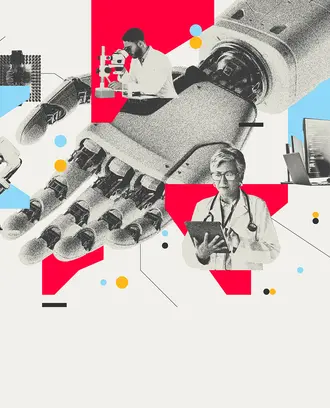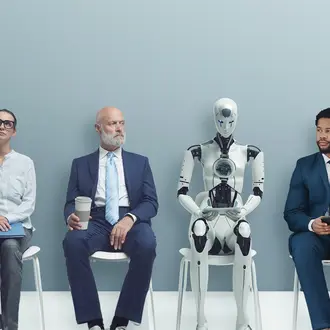Credit: Jack Frog / Shutterstock
Ageism in the workplace is a growing concern. A recent Washington Post story on the futility of age-discrimination lawsuits highlighted two troubling data points: In a recent survey conducted by the American Association of Retired Persons, 61% of workers 45 and older reported seeing or experiencing age discrimination. And a study by the Urban Institute and ProPublica found that 56% of workers 50 or older were pushed out of longtime jobs before they chose to retire.
This economic and ethical conundrum will affect an ever-growing number of people. In 1990, one in five U.S. workers was older than 50. These days, one in three of your office mates remembers the days before Twitter, TikTok, and maybe even cable TV.
The rise in older workers is partly attributed to more “age-friendly jobs,” according to a new working paper by MIT professorNicolaj Søndergaard Mühlbach of McKinsey, and London Business School professor Andrew J. Scott.
In “The Rise of Age-Friendly Jobs,” researchers found that between 1990 and 2020, around three-quarters of occupations became more suitable for older workers. In fact, employment in more age-friendly occupations, such as human resources management and insurance sales, has risen by 49 million.
But, unfortunately, the increase in age-friendly jobs didn’t disproportionately benefit older workers. According to the researchers, the age-friendly jobs that appeal to older workers also appeal to younger women and college graduates.
What makes jobs “age-friendly”
Age-friendly jobs involve less physical exertion, greater use of social and communication skills, and less harsh environmental conditions.
Older people want jobs with greater autonomy (as measured by the ability to set their own schedule or work alone) as well as jobs that involve moderate physical activity or more sitting, according to the researchers. They prioritize scheduling flexibility, even if it means less money. They also want shorter commutes or the option for remote work, less demanding cognitive and physical work, and reduced job stress.
In 2020, the most age-friendly jobs were guides; reservation and ticket agents; receptionists; advertising and sales; human resources and labor relations managers; proofreaders; insurance sales; business and promotion agents; insurance investigators; and secretaries and stenographers.
Employment in more age-friendly occupations, such as human resources management and insurance sales, has risen by 49 million since 1990.
The least age-friendly jobs were labor-heavy pursuits such as carpentry, masonry, cement work, and painting, according to the researchers.
The researchers created an Age-Friendliness Index to examine whether U.S. occupations have become more accommodating to older workers over the years. The team drew from the U.S. Department of Labor’s O*NET descriptions of 244 job attributes for 873 occupations, with a focus on nine key categories: schedule flexibility, telecommuting, physical job demands, pace of work, autonomy at work, paid time off, working in teams, job training, and meaningful work. Machine learning algorithms correlated 17,000 O*NET occupation descriptors with the nine age-friendly categories.
The researchers found that as jobs became more age-friendly, there was a twist: Most age-friendly jobs haven’t been snapped up by older workers. Despite a 33.1 million increase in employment in the top quartile of age-friendly occupations, just 15.2 million was accounted for by workers over 50, whereas female and college graduates account for most of the more age-friendly jobs that have been created since 1990.
Men make up 69% of employment in the least age-friendly occupations, the researchers found.
Potential reasons for these outcomes include that women and college graduates prize the same working characteristics as older workers, such as less physical exertion and using social and communication skills. Moreover, the researchers posit that older workers might be unwilling or unable to segue from their existing jobs into age-friendlier ones. And employers might prefer younger workers, who are perceived to be more productive.
Why we need age-friendly employment
Related Articles
The importance of age-friendly jobs is twofold, the researchers found. First, reducing the potential harmful effects of work for older people “should lead to greater involvement in the labor market for older workers, a key policy objective in an aging society,” they write. “Second, by creating opportunities that are most attractive to older workers, they minimize the impact on wages and employment at other ages.”
Employment in more age-friendly occupations increased by 44% since 1990, compared with a 21% increase for less age-friendly occupations. Because of the overlap in desirable occupational characteristics between older and younger workers, the creation of age-friendly jobs is good practice overall. However, the researchers warn that there’s more work to do.
“The manner in which older graduates have benefited from age-friendly jobs compared to non-graduates, especially males, points to the need to think not of general age-based policies but more targeted policies,” the researchers write. “[There is] a need for policies focused in particular on older male non-graduates and supporting improvements in the age-friendliness of existing occupations or aiding transitions to more age-friendly occupations.”
Read next: 5 traits of the workforce of the future



